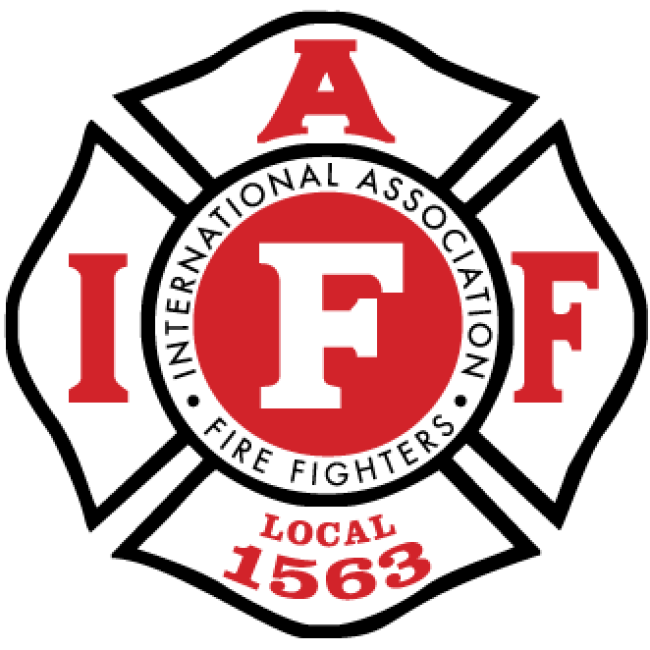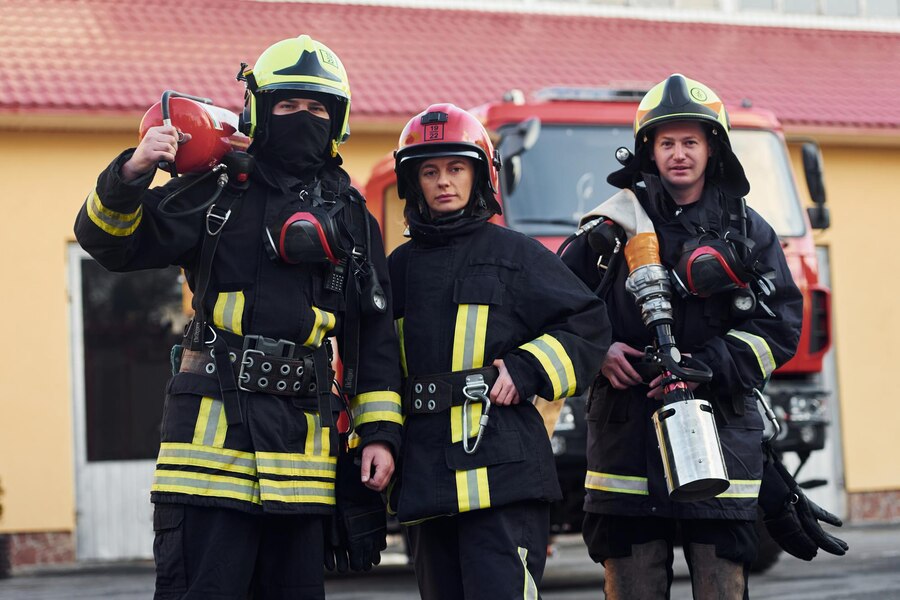Firefighter training is a critical component in preparing recruits for the demanding and hazardous nature of the job. It equips them with essential skills, from fire safety and emergency medical response to handling hazardous materials and executing search and rescue operations. This training ensures their safety and enhances their ability to protect and save lives effectively. For every recruit, comprehensive firefighter training is the foundation of a successful and impactful career in firefighting.
The Fundamentals of Firefighter Training
Firefighter training is comprehensive, covering many skills and knowledge essential for effectively combating fires and responding to emergencies. Here are the key fundamentals of firefighter training:
- Fire Behavior and Control: Understanding how fires start, spread, and are controlled is crucial. This knowledge enables firefighters to predict fire progression and develop effective strategies for containing and extinguishing fires safely and efficiently.
- Physical Fitness and Endurance: The physical demands of firefighting require high levels of strength, stamina, and agility. Training programs include rigorous exercises to build physical fitness, ensuring firefighters can handle the strenuous tasks involved in firefighting.
- Emergency Medical Training: Firefighters often serve as first responders to medical emergencies. Training includes CPR, first aid, and trauma care, equipping firefighters with the skills to provide immediate medical assistance and save lives during emergencies.
- Handling Hazardous Materials: Firefighters learn to identify and manage hazardous materials safely. Training covers containment, decontamination procedures, and the use of protective gear, ensuring they can handle dangerous substances without compromising safety.
- Search and Rescue Operations: Effective search and rescue techniques are vital for locating and saving individuals in emergencies. Training includes systematic search methods, victim assessment, and evacuation procedures, ensuring firefighters can perform rescues efficiently and safely.
Physical Fitness and Endurance
Given the physically demanding nature of the job, physical fitness and endurance are pivotal elements of firefighter training. Firefighters must maintain peak physical condition to perform strenuous tasks, such as carrying heavy equipment, rescuing individuals from dangerous situations, and enduring extreme temperatures. The training regimen includes strength training, cardiovascular exercises, and flexibility workouts designed to enhance overall physical capability and reduce the risk of injury.
Endurance training is equally essential, as firefighting often involves extended periods of intense activity. Recruits undergo rigorous conditioning to build stamina and sustain high exertion levels during prolonged emergency operations. This aspect of training prepares firefighters for the physical challenges they will face and instills discipline and resilience, crucial traits for managing the stress and demands of their vital role.
Fire Safety and Prevention Techniques
Fire safety and prevention techniques are essential components of firefighter training to minimize risks and prevent fire incidents. Here are five essential techniques every firefighter must master:
- Understanding Fire Behavior: Learning how fires start, spread, and are controlled is crucial. This knowledge helps firefighters predict fire progression and develop effective strategies for combating fires, ensuring quicker containment and minimizing damage to properties and lives.
- Fire Risk Assessments: Conducting thorough inspections of buildings and environments helps identify potential fire hazards. Firefighters implement safety measures to mitigate risks, ensuring environments are safer and less prone to fire incidents, thereby protecting lives and property.
- Public Education: Educating the community on fire prevention strategies is essential. This includes teaching proper use of electrical appliances, safe cooking practices, and the importance of smoke detectors, helping to reduce the occurrence and impact of fires.
- Use of Fire Extinguishers: Training on fire extinguishers’ types and proper use ensures firefighters can quickly respond to small fires. This prevents escalation, reducing potential damage and increasing safety for individuals and property during initial fire incidents.
- Evacuation Procedures: Developing and practicing clear evacuation plans for various buildings and scenarios ensures occupants’ safe and orderly exit during emergencies. These procedures are crucial for minimizing injuries and fatalities during fire incidents.
Emergency Medical Training
Emergency medical training is critical to firefighter training, equipping recruits with the skills necessary to provide immediate medical assistance in emergencies. Here are the critical components of this training:
- Basic Life Support (BLS): Firefighters learn essential life-saving techniques, including CPR (cardiopulmonary resuscitation) and the use of automated external defibrillators (AEDs). These skills are crucial for responding to cardiac emergencies and other life-threatening conditions.
- First Aid and Trauma Care: Training covers many first aid procedures, from treating minor injuries to managing severe trauma. Firefighters learn how to control bleeding, treat burns, stabilize fractures, and care for various emergencies until professional medical help arrives.
- Patient Assessment: Firefighters are trained to quickly and accurately assess a patient’s condition. This includes checking vital signs, identifying symptoms, and determining the appropriate action to ensure effective and timely medical intervention.
- Advanced Medical Procedures: Some firefighter training programs include advanced medical techniques, such as intubation, intravenous (IV) therapy, and the administration of medications. These skills enable firefighters to provide more comprehensive care in critical situations.
- Medical Equipment Proficiency: Firefighters must use various medical equipment, including oxygen tanks, splints, and medical kits. Proper training ensures they can effectively utilize these tools during emergencies, enhancing their ability to save lives and provide quality care.
Handling Hazardous Materials
Handling hazardous materials is crucial to firefighter training, preparing recruits to manage incidents involving dangerous substances safely. This training includes identifying hazardous materials, such as chemicals, gases, and biological agents, and understanding their potential risks. Firefighters learn specific containment and decontamination procedures to prevent the spread of hazardous substances and protect themselves and the public.
Additionally, training covers using specialized protective gear and equipment, ensuring firefighters are adequately protected during hazardous material incidents. Communication and coordination with specialized hazardous materials (HazMat) teams are also emphasized, ensuring a cohesive and efficient response. This comprehensive training equips firefighters with the knowledge and skills to handle hazardous material situations effectively, safeguarding communities and the environment.
Search and Rescue Operations
Search and rescue operations are vital to firefighter training, enabling firefighters to locate and save individuals in emergencies effectively. Here are critical aspects of search and rescue training:
- Search Techniques: Firefighters learn systematic search methods for different scenarios, such as structure fires, natural disasters, and confined spaces. These techniques ensure thorough and efficient searches to locate missing or trapped individuals.
- Victim Assessment and Stabilization: Training includes evaluating the condition of found victims and providing immediate medical care. This ensures that victims receive the necessary attention to stabilize their condition before evacuation.
- Evacuation Procedures: Firefighters are trained in various evacuation strategies, including ropes, ladders, and specialized equipment. This ensures the safe and swift removal of victims from hazardous environments.
- Use of Search and Rescue Tools: Proficiency in using tools such as thermal imaging cameras, listening devices, and rescue saws is critical. These tools help locate victims and clear obstacles during rescue operations.
- Team Coordination and Communication: Effective search and rescue operations require seamless teamwork and communication. Firefighters practice coordinating with their team members and other emergency responders to ensure a unified and efficient response during emergencies.
Teamwork and Communication Skills
Teamwork and communication skills are vital for firefighters, ensuring effective coordination and safety during emergency responses. Here are critical aspects of this training:
- Effective Communication Protocols: Firefighters learn standardized communication protocols, including radio usage and hand signals, to ensure clear and accurate information exchange during operations. This reduces misunderstandings and enhances coordinated efforts in high-stress environments.
- Role Clarity and Coordination: Training emphasizes understanding each team member’s role and responsibilities. This clarity allows for seamless coordination during complex tasks, ensuring that all aspects of an operation are covered efficiently and effectively.
- Building Trust and Camaraderie: Team-building exercises and collaborative training sessions foster trust and camaraderie among firefighters. Strong interpersonal bonds enhance teamwork, making it easier to rely on each other in critical situations.
- Conflict Resolution Skills: Firefighters are trained in conflict resolution techniques to manage disagreements and maintain a cohesive team dynamic. Effective conflict resolution ensures that personal differences do not hinder operational efficiency or safety.
- Leadership Development: Training includes developing leadership skills, enabling firefighters to take charge when necessary, and guiding their team through challenging situations. Strong leadership is crucial for making quick, informed decisions during emergencies.
Continuous Education and Advanced Training
Continuous education and advanced training are critical for maintaining and enhancing a firefighter’s skills. Firefighters must stay updated with the latest techniques, equipment, and safety protocols to respond effectively to evolving challenges. This ongoing training includes specialized courses in advanced fire behavior, hazardous materials management, and high-angle rescue operations.
Participation in workshops, simulations, and real-world drills helps firefighters refine their skills and adapt to new technologies and methods. Additionally, pursuing certifications and advanced degrees in fire science and emergency management further enhances their expertise. By committing to continuous education and advanced training, firefighters ensure they remain proficient, prepared, and capable of providing their communities the highest level of service.
Firefighter training is the foundation for every recruit’s success and safety in the field. Comprehensive training equips firefighters with the skills and knowledge to handle emergencies, save lives, and protect property effectively. By mastering fire behavior, physical fitness, emergency medical care, hazardous material handling, and search and rescue operations, recruits are prepared for the job’s demands.
If you’re ready to join the ranks of highly trained firefighters, contact IAFF Local 1563 today at 410-987-1180. Our expert training programs will prepare you for a rewarding and impactful career in firefighting.

